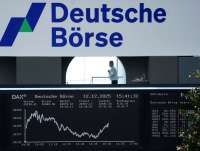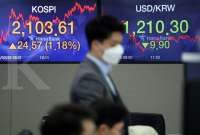FEDERAL RESERVE - WASHINGTON. The Federal Reserve on Wednesday took a rosier view of the U.S. economic recovery and the nation's war against the coronavirus, but said it was too early to consider rolling back its emergency support with so many workers still left jobless by the pandemic.
"It is not time yet" to begin discussing any change in policy, Fed Chair Jerome Powell told reporters after the release of a policy statement in which the U.S. central bank left interest rates and its bond-buying program unchanged.
"We are 8.5 million jobs below February 2020," Powell said. "We are a long way from our goals ... It is going to take some time."
Though inflation is due to rise, Powell said the coming price increases would almost surely be of a passing nature, and not present the sort of persistent problem that would force the Fed to begin raising interest rates sooner than expected.
As it stands, the central bank wants to keep monetary policy loose for the foreseeable future even as it sees the economic recovery gaining pace and the risks from the pandemic starting to ebb.
It is not just the easing of the health crisis and the associated reopening of the economy that is propelling the United States towards its strongest economic growth since the 1980s. Washington's crisis-fighting programs are continuing to funnel money to businesses and households, boosting personal income and spending.
Read Also: South Korea to lift mandatory quarantine for residents fully vaccinated against COVID
And in a speech to a joint session of Congress later on Wednesday, President Joe Biden will pitch new infrastructure and social spending programs that could add trillions of dollars to the economy in coming years.
"Amid progress on vaccinations and strong policy support, indicators of economic activity and employment have strengthened," the central bank's policy-setting Federal Open Market Committee (FOMC) said in a unanimous statement, with improvement seen even in the industries hardest hit by the onset of the pandemic.
While repeating that "the path of the economy will depend significantly on the course of the virus," the Fed appeared to take a less downcast view of the ongoing health crisis than it did even last month.
In its statement after the March 16-17 policy meeting, the Fed portrayed the coronavirus as posing "considerable risks to the economic outlook." On Wednesday, it said "risks to the economic outlook remain" because of the virus.
Coupled with the strong language on the economy's prospects, analysts said the Fed's tone suggested at least a small step towards the start of a discussion about when to wean the economy from crisis-era programs.
"It is very much tiptoeing in the direction of a stronger economic backdrop that could potentially justify tapering and eventual rate increases," said Steven Violin, portfolio manager for F.L.Putnam Investment Management Company in Wellesley, Massachusetts.
That won't require the country to reach any particular benchmark in its fight against the spread of COVID-19, Powell said. Though he noted the economy likely would heal only if there was "really significant progress" against the disease, he also said ongoing outbreaks would not necessarily prevent the Fed from changing monetary policy if its economic tests for doing so are met.
"We have not articulated a separate test for the state of the virus that we would like to achieve," Powell said. "There is a possibility of course that we will have ongoing outbreaks over the summer ... And potentially next winter as well. But we will be looking for substantial further progress towards our goals" on employment and inflation.
The Fed left unchanged the list of conditions for improvements in employment and inflation, first set in December, that must be met before it considers pulling back from the support put in place last year to stem the pandemic's economic fallout, which includes $120 billion in monthly purchases of government bonds and mortgage-backed securities.
Read Also: Japan's retail sales rise at fastest pace in five months
MONTHS DOWN THE ROAD
Investors and analysts had expected this week's Fed meeting would see little if any change to the policy statement, and the reaction in financial markets was muted.
The benchmark S&P 500 index ended the session slightly lower and yields on U.S. Treasury securities fell. The dollar weakened against a basket of key trading partner currencies.
U.S. job growth has been accelerating and the Fed expects inflation to rise to its 2% target over time, eventually allowing it to trim its bond purchases and raise its target overnight interest rate from the current level near zero.
Even that first step of tapering bond purchases is likely months down the road, and the Fed gave no indication on Wednesday that there is any rush.
The coming weeks could prove telling. Economists in general are expecting continued strong job growth. If the most bullish forecasts come to pass, the Fed may at least start debating such moves at its policy meeting in June.
"We continue to see employment as the key catalyst for the Fed and markets this year as inflation is simply too noisy to matter," economists from Jefferies wrote after the release of the Fed's statement. "Our preliminary forecast for April payrolls is 2.1 million. If that's followed by another 1 million gain in May, the June FOMC meeting will be much more interesting."
Read Also: Google sales top estimates on ad surge; Alphabet plans $50 billion buyback
/2019/03/19/1161668377p.jpg)









